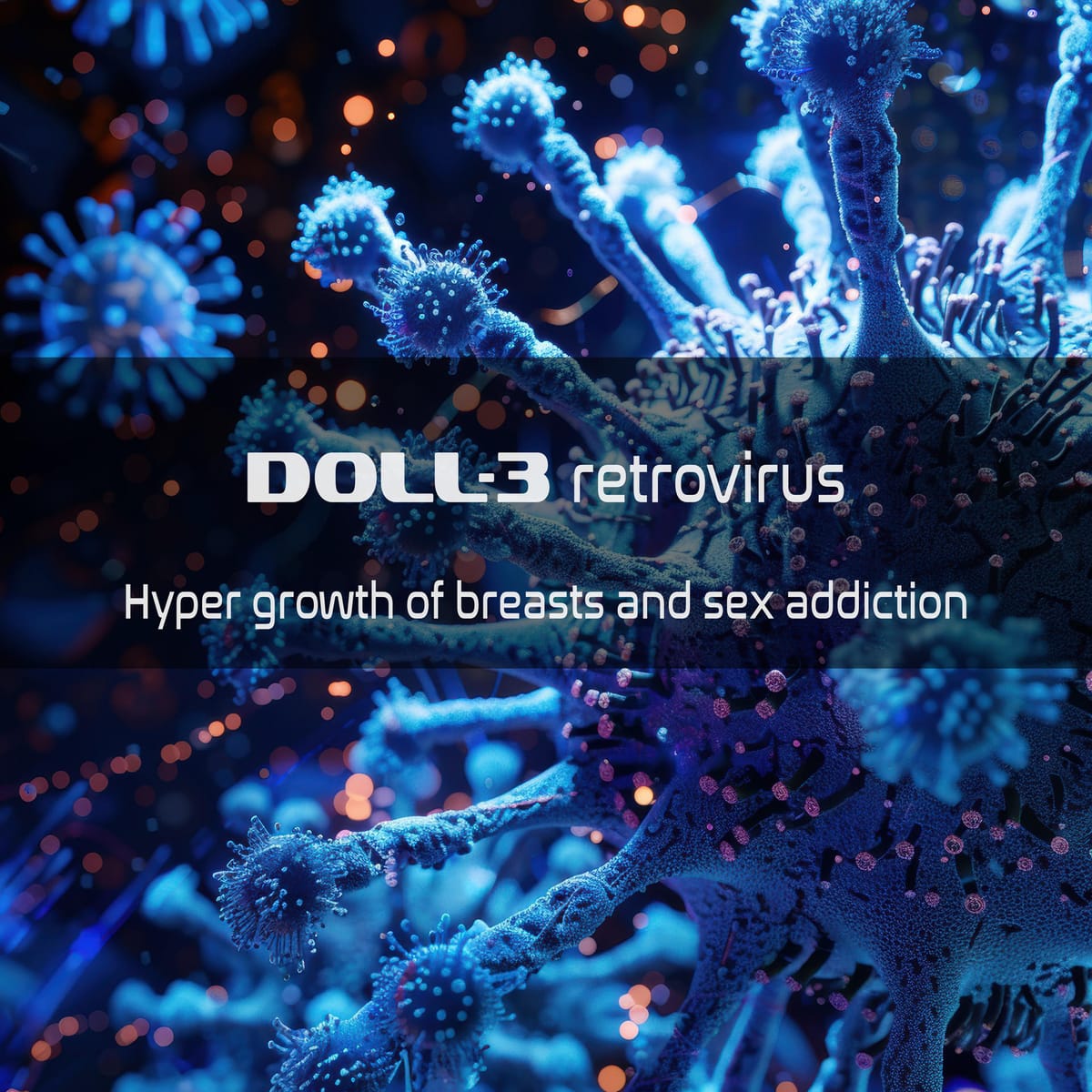Dossier: Gene Therapy Retrovirus DOLL-3
To enhance breast tissue growth and libido in women through targeted gene therapy, while addressing the limitations of its predecessor, DOLL-2.

Project Name: DOLL-3 (Directed Organ Lateral Locus 3)
Origin: Developed by NewCon as a refinement of DOLL-2, intended to create physically idealized women for use by high-status incel-aligned elites. Unlike its predecessor, DOLL-3 was broadly applied on the female population in Imperial Norway by the Novi Soviet occupiers. The DNA change became inherited through the matrilineal lineage.
Objective
To surpass the limitations of DOLL-2 by inducing more pronounced physical changes, including extreme breast and body curvature, heightened libido, and incidental lactogenic activation. Although the primary focus remained aesthetic and behavioral compliance, additional physiological effects emerged—some of which were later co-opted by state institutions or fringe subcultures.
Overview
DOLL-3 is a retroviral gene therapy. By rewriting hormonal regulation pathways, it simulates the endocrine states of late puberty and early pregnancy. The therapy introduced a synthetic gene complex—now commonly referred to as the DOLL-3 gene complex—which enhances mammary development, fat redistribution, lactogenic sensitivity, and limbic arousal responses.
The gene complex is now typically inherited, passed from mother to daughter through the germline. As a result, most women in Imperial Norway today express the DOLL-3 modifications—whether desired or not.
Mechanism of Action
DOLL-3 targets a range of tissues responsive to estrogen, growth hormone, dopamine, and prolactin. Core genetic modifications include:
Increased Mammary Tissue Growth
- Gene: ESR1 (Estrogen Receptor 1)
- Modification: Strong upregulation of estrogen receptors, causing significant breast tissue growth. The response exceeds natural puberty, leading to hypertrophy in many cases.
Enhanced Adipose Tissue Accumulation
- Gene: PPARγ (Peroxisome Proliferator-Activated Receptor Gamma)
- Modification: Promotes fat storage in breasts, hips, thighs, and buttocks. Results in a highly exaggerated hourglass form. Often described clinically as non-pathological steatopygia.
Improved Hormonal Sensitivity
- Gene: GHR (Growth Hormone Receptor)
- Modification: Increases responsiveness to growth hormone and IGF-1, enhancing soft tissue growth and regeneration.
Enhanced Collagen Production
- Gene: COL1A1 (Collagen Type I Alpha 1 Chain)
- Modification: Supports tissue elasticity and structural integrity, preventing tearing or stretch damage despite extreme volumetric change.
Heightened Libido and Reward Pathways
- Gene: DRD4 (Dopamine Receptor D4)
- Modification: Amplifies sexual desire by increasing dopamine sensitivity in the mesolimbic pathway. Designed to foster emotional dependence and erotic responsiveness.
Incidental Lactogenic Activation
- Gene: PRLR (Prolactin Receptor)
- Modification: Sensitizes breast tissue to prolactin, resulting in spontaneous milk production in most subjects by late adolescence.
- Milk may accumulate for several days, causing warmth, tenderness, and emotional craving for release.
- Although not a design goal, the drive to offer milk has emerged as a strong behavioral pattern, particularly toward romantic or emotionally close individuals.
- Many subjects report psychological distress when unable to offer milk or be suckled, including feelings of rejection, emotional blockage, or damaged self-worth.
Clinical Observations
Subjects enhanced with DOLL-3 typically demonstrate:
- Dramatic enlargement of breasts, hips, and buttocks
- Heightened sexual drive and affectionate intensity
- Regular or cyclical milk production regardless of pregnancy
- Deep-seated desire to offer breast milk as an emotional gift
- Strong psychological response to physical touch, especially oral stimulation of the breasts
Notable Side Effects
Hyperplasia of Breast Tissue
- In some cases, growth continues past safe anatomical limits, requiring medical support or custom garments. Untreated cases can impair balance and daily function.
Compulsive Sexual Behavior
- Subjects frequently require multiple sexual releases per day to maintain emotional and cognitive stability.
- Extended abstinence leads to brain fog, mood instability, and inability to focus.
- Medical guidance recommends a minimum of four sexual or orgasmic events per day for stable psychological performance in DOLL-3-enhanced women.
Emotional Dysregulation via Milk Retention
- The accumulation of milk, particularly if not received by someone close, can cause a cascade of emotional symptoms:
- Anxiety
- Depressive episodes
- Obsessive questioning of self-worth ("Why doesn’t he want my milk?")
- Disruptive fixation on validation through suckling
Attachment Dysphoria
- Strong bonding responses, often one-sided, may develop toward individuals who accept a subject’s milk. Rejection or lack of reciprocation can cause emotional withdrawal or panic responses.
Skewed Sex Ratios via Male Embryo Loss
One of the most profound unintended consequences of the DOLL-3 gene complex is its effect on reproduction. Clinical monitoring revealed that pregnancies in DOLL-3 carriers overwhelmingly result in female offspring. Investigations suggest the following mechanism:
Immunological Selection Against Male Embryos
- The DOLL-3 modifications amplify maternal immune surveillance within the uterine environment.
- Upregulated HLA-G and NK cell activity appears to misidentify male embryos—particularly those expressing Y-chromosome–linked antigens—as aberrant tissue.
- This triggers a disproportionate rate of early miscarriage for XY conceptions, often occurring before clinical confirmation of pregnancy.
Endocrine Reinforcement
- The heightened estrogenic state fostered by DOLL-3 therapy further destabilizes androgen-dependent embryonic pathways.
- Combined with immune rejection, this produces a near-total suppression of viable male births.
Demographic Consequence
- In Imperial Norway, live births to DOLL-3 carriers are estimated at >98% female.
- The effect has become self-reinforcing, as the therapy is now fixed in the germline.
- Male births are rare, often celebrated as national events, and surrounded by both cultural reverence and anxiety.
Delivery Method
DOLL-3 is administered via direct intramuscular injection. The active retroviral solution—DOLL-3 Vector Serum—is stored cryogenically and requires sterile thawing procedures. Full activation occurs within 1–2 weeks, with physical changes developing over 3–6 months.
Applications and Later Adaptations
Though originally designed for erotic and aesthetic purposes, DOLL-3’s broader effects shaped entire sectors of society in Imperial Norway, especially in ritual, education, and maternal therapy. Ritual suckling, “milk gifting,” and coordinated orgasmic routines are now normalized in many institutional contexts.
In other regions, DOLL-3 was repurposed for unofficial use—especially in fringe societies exploring lactation-based rituals or productivity modifications. These applications were never part of the original design, and reflect opportunistic adaptations of a flawed but potent technology.
Summary
DOLL-3 is a radical human augmentation protocol that reshaped not only the female body, but the cultural expectations placed upon it. While initially created for sexual idealization and emotional dependency, its unintended effects—especially surrounding lactation, intimacy regulation, and cognitive dependence on pleasure—have defined its legacy.
The problem induced with giving birth to boys has also contributed to deeply skewed sex demographics.




